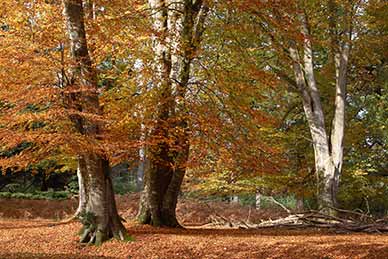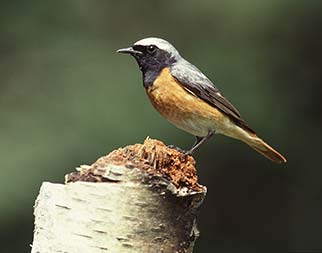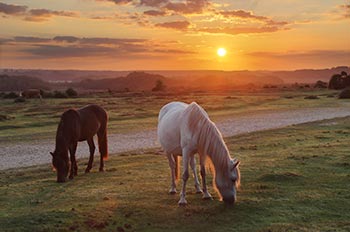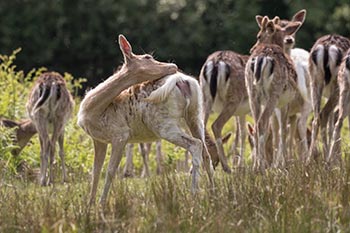Ancient, unenclosed woodlands

Visit one of the New Forest’s ancient, unenclosed woodlands and experience woodland as the Saxons knew it, woodland that would be familiar to Roman, Iron and Bronze Age peoples.
Conjure scenes of spring in the mind’s eye, of vaulted arches clad in fresh green foliage, with high above, redstarts singing scratchy, jangling tunes. Notice the commoners’ stock, and deer, free to wander at will, to browse and graze just where they please. Then think of autumn, the trees ablaze with seasonal glory. Rutting fallow deer bellow from the mating stands, fungi adorn the forest floor, and pigs gorge on the fallen acorn crop, just as in generations past.
Rich landscapes of contorted, moss-clad trunks, many of these ancient, unenclosed woodlands have not for centuries felt the hand of man, have not in recent times heard sounds of axe or saw. Left to live their natural span, veteran trees fall in the wind, and now decay on the woodland floor. Others that have managed to evade the stock and deer spring up to fill the gaps. Many clearings, though, remain; created randomly by nature’s force.
And alright, these ancient, unenclosed woodlands are not completely free of man’s influence. Stock and deer numbers are regulated, trees have been felled or pollarded, fences are occasionally used to encourage re-generation, a little selective thinning is undertaken, and some planting has taken place, but not in the regimented rows of forestry inclosures.
Elsewhere in much of Britain and western Europe, little ancient, unenclosed woodland remains. Yet in the New Forest, much survives, most within self-contained woods, but some in drift-ways between forestry inclosures, and as remnants trapped behind inclosure fences.
In these ancient, unenclosed woodlands, ground level and under-storey vegetation is often largely absent, stripped bare by stock and deer, but aged holly trees survive, their horizontal skirts are browse lines that indicate the very limit of reach of these animals.
Many of the holly trees have in the past been coppiced, their stems cut at ground level to encourage the rapid growth of multiple shoots for use as browse for hungry animals, or else for the Christmas trade. Others have been pollarded, the cut made for the same purpose, but just out of browsing reach.
Beech and oak, too, once were pollarded, and now exhibit thick, multiple stems shooting skywards from a single trunk. Trees such as this are likely to be amongst the oldest in the New Forest for in 1698, pollarding of ‘timber trees’ was forbidden in legislation designed to promote the growth of stouter, single trunks much needed by the Navy. But trees that had previously been pollarded, probably continued to be cut; and some illegal pollarding almost certainly took place.
In recent years, however, these species have again been pollarded, and so have holly and ash, cut to improve the woodland’s diversity, to open up gloomy, holly-filled interiors, to provide space for crowns to spread and homes for insects and lichens that seem to prefer pollard trees more than any others.
Indeed, sheltered from desiccating winds, and regularly one or two degrees warmer than surrounding open land, the woodland micro-climate encourages the growth of myriad mosses and lichens, all indicators of clean New Forest air.

Other wildlife interest is also considerable.
Hole and crevice nesting birds thrive amongst the dead and decaying timber - great spotted woodpeckers, lesser spotted woodpeckers, green woodpeckers, nuthatches, blue tits, great tits, marsh tits, tawny owls and spring and summer-visiting redstarts, for example - whilst significant populations of bats find roost sites in the hollow trees.
Invertebrates, too, take advantage of the rotting wood. Hornets, enormous, but largely docile creatures, build their nests within, whilst the increasingly scarce stag beetle spends its early life stages out of sight of prying eyes, deep inside decaying timber.
Fungi proliferate, both on the trees and amongst the leaf litter, active participants in nature’s ceaseless recycling of materials.
Fox, badger and deer roam free, whilst many species of wild flowers grow here, too, including some considered indicative of ancient woodland. But extensive patches of colour created by sheets of bluebells and wood anemones, for example, are largely absent, victims of hungry animals and trampling hooves. The delicate blooms of wood sorrel, though, survive in reasonable numbers and so, too, do foxgloves - with their poisonous foliage and flowers - and prickly stemmed butcher's broom.
The New Forest Act of 1877 referred to ‘ancient ornamental woods’ and those words continue to be fitting, although not all these open, pasture woods are ancient.
Visit, though, at any time of year and in any weather, and amongst these trees, energise the spirit.
References:
The New Forest – A Natural History: Colin R. Tubbs
More links
Other related links
Search this site

Sadly, 58 animals were killed - 35 ponies, 13 cows, 8 donkeys and 2 sheep, whilst a further 32 were injured - 3 pigs, 9 donkeys, 11 cows and 9 ponies.
(Forty-three accidents occurred in daylight, 15 at twilight and 101 in the dark. Twenty-seven accidents were not reported by the driver involved).
Here's just one horrific example - Three donkeys killed in collision with van at notorious New Forest blackspot (Advertiser and Times)


Honeysuckle, an early harbinger of spring, shows signs of new growth.
Bird sounds, great tit calls and mistle thrush song, for example, are increasingly heard as the days lengthen and spring rapidly approaches.
Foxes breed during the early months of the year. Their presence is betrayed by barks after darkness falls.
February
Great grey shrikes hunt over heathland from tree-top vantage points and other perches.
Grey squirrels are often best seen in winter when deciduous trees are devoid of leaves.
Red Admirals and other butterflies that over-winter as adults may be on the wing on warm, bright days.
Roe deer antlers continue to develop - they are cast and re-grown annually.

